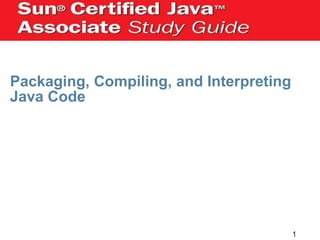The document covers the concepts of packaging, compiling, and interpreting Java code, emphasizing the purpose of packages in organizing related classes and promoting code reuse and encapsulation. It explains the structure and syntax of package statements, import statements, and how to compile and run Java programs using the 'javac' and 'java' commands with proper options. Additionally, it discusses the use of static imports, class paths, and the implications of import statements on compilation and runtime behavior.






















![15. What happens when you try to compile and run the
following code?
public class Q15 {
static String s;
public static void main(String[] args) {
System.out.println(“>>” + s + “<<”);
}
}
A. The code does not compile
B. The code compiles, and prints out >><<
C. The code compiles, and prints out >>null<<
Ben Abdallah Helmi Architect en
23
J2EE](https://image.slidesharecdn.com/chapter1-131111094840-phpapp02/85/Chapter-1-23-320.jpg)


















![Compiling with javac
• javac [options] [source files]
• javac -help
• javac -classpath com:. -g Foo.java
Bar.java
• Whenever you specify multiple options
and/or files they should be separated by
spaces.
42](https://image.slidesharecdn.com/chapter1-131111094840-phpapp02/85/Chapter-1-42-320.jpg)



![Launching Applications with java
• In Chapter 5 we talked about the assertion mechanism
and when you might use flags such as -ea or -da when
launching an application.
• java [options] class [args]
java -DmyProp=myValue MyClass x 1
• Sparing the details for later, this command can be read as "Create a system property called
myProp and set its value to myValue. Then launch the file named MyClass.
• class and send it two String arguments whose values are x and 1."
46](https://image.slidesharecdn.com/chapter1-131111094840-phpapp02/85/Chapter-1-46-320.jpg)
![Using System Properties
If this file is compiled and invoked
as follows:
import java.util.*;
java -DcmdProp=cmdVal TestProps
public class TestProps {
public static void main(String[] args) { You'll get something like this:
...
Properties p =
os.name=Mac OS X
System.getProperties();
myProp=myValue
p.setProperty("myProp", "myValue");
...
p.list(System.out);
java.specification.vendor=Sun Microsystems Inc.
}
user.language=en
java.version=1.5.0_02
}
...
cmdProp=cmdVal
...
47](https://image.slidesharecdn.com/chapter1-131111094840-phpapp02/85/Chapter-1-47-320.jpg)

![Handling Command-Line Arguments
public class CmdArgs {
compiled and then invoked as follows
public static void main(String[]
java CmdArgs x 1
args) {
the output will be
int x = 0;
0 element = x
for(String s : args)
1 element = 1
System.out.println(x++ + "
element = " + s);
}
} The following are all legal declarations for main():
static public void main(String[] args)
public static void main(String... x)
static public void main(String bang_a_gong[])
49](https://image.slidesharecdn.com/chapter1-131111094840-phpapp02/85/Chapter-1-49-320.jpg)









![Compiling and Interpreting Java Code
• The Java compiler is invoked with the javac[.exe] command.
• The .exe extension is optional on Microsoft Windows machines and is not
present on UNIX-like systems.
• The compiler’s -d command-line option defines where compiled class files
should be placed.
• The compiler’s -d command-line option will include the package location if
the class has been declared with a package statement.
• The compiler’s -classpath command-line option defines directory paths in
search of classes.
• The Java interpreter is invoked with the java[.exe] command.
• The interpreter’s -classpath switch defines directory paths to use at runtime.
• The interpreter’s -D command-line option allows for the setting of system
property values.
• The interpreter’s syntax for the -D command-line option is -Dproperty=value.
• The interpreter’s -version command-line option is used to return the version
of the JVM and exit.
59](https://image.slidesharecdn.com/chapter1-131111094840-phpapp02/85/Chapter-1-59-320.jpg)












